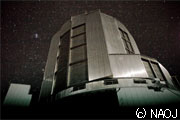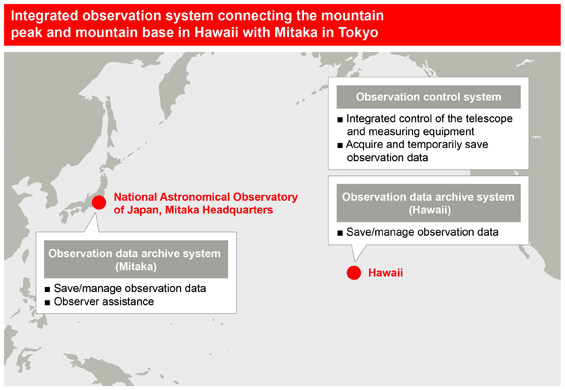Archived content
NOTE: this is an archived page and the content is likely to be out of date.
Subaru Telescope Hawaii
Challenge – Develop the world's largest optical-infrared telescope


Answer – End-to-end offering from Fujitsu
Building on a 30-year partnership and several successful astronomical projects, NAOJ selected Fujitsu to build the observation control system and observation data archive system for the Subaru telescope(note 1). Key factors in favor of Fujitsu included its global support capabilities, proven system integration expertise in the field of astronomy and ability to develop a uniform, end-to-end architecture covering all solution layers from observation control and data collection through to storage management and data analysis.
Observation control system
For maximum reliability and usability, Fujitsu used PRIMERGY servers, PRIMEPOWER UNIX servers and ETERNUS storage systems to build the observation control system. It controls the telescope's direction and positioning, capturing huge volumes of observation data (approximately 50 GB per night, with approximately 10,000 files) and transfers this data to the observation data archive in Hawaii. Observers can easily control the telescope by pointing it, for instance, at a particular astronomical object.
Observation data archive system
Up to 20 MB of data is transferred every second by the various Subaru observational instruments. To accommodate this data stream, Fujitsu developed a data archiving and management solution with PRIMERGY servers, PRIMEPOWER UNIX servers and ETERNUS storage systems. Data is mirrored between Hawaii and Japan to ensure redundancy. Approximately 4 million files are currently stored.
Benefits – Advancing astronomy research
Global support from Fujitsu was a key success factor for this project ? helping to smoothly bridge the gap between Japan, the US and Hawaii. The Subaru telescope functions reliably, streaming massive volumes of data every day to the archiving systems in Japan and Hawaii. Astronomers from all over the world have access to this data, paving the way for new scientific breakthroughs and insights.
The Subaru Telescope has already enabled great scientific discoveries. Sensitive cameras with advanced technology have captured sharp images leading to the discovery of objects in the exotic world beyond our solar system. This is allowing scientists to explore exoplanets, namely planets orbiting stars other than the sun. These reveal a wide range of environmental conditions.
In addition, the Subaru Telescope helped to discover the farthest galaxy ever. This was enabled by wide-field imaging, followed by an accurate measurement of the distance. Such galaxies give valuable insights into the history of the Universe by revealing the conditions that prevailed in the past.
Footnote
1: Subaru telescope
The Subaru telescope is a large optical-infrared telescope with one of the world's largest single mirrors and an inner diameter of 8.2 m. It is located on the summit of Mauna Kea (4,205 m altitude) on the island of Hawaii.


